Culture and Diversity: Islamic Culture, Practices, and Intersection
VerifiedAdded on 2022/11/15
|5
|974
|84
Essay
AI Summary
This essay provides an analysis of Islamic culture and diversity, focusing on the concept of cultural relativism. It explores various aspects of Islamic practices, including the significance of Ramadan, which involves fasting for 30 days and its spiritual and medical benefits, such as improved self-control and potential health advantages. The essay also examines the importance of Islamic prayers (Salat), performed five times daily, and their impact on an individual's productivity and physical well-being. Furthermore, it delves into Islamic architecture, highlighting the distinctive features like domes, arches, and muqarnas vaults, and discusses cultural intersections with other traditions like Jainism, Buddhism, Turkish, Roman, and Persian cultures. The essay incorporates various sources and references to support its arguments and provides a comprehensive understanding of Islamic culture and its interactions with other cultures.
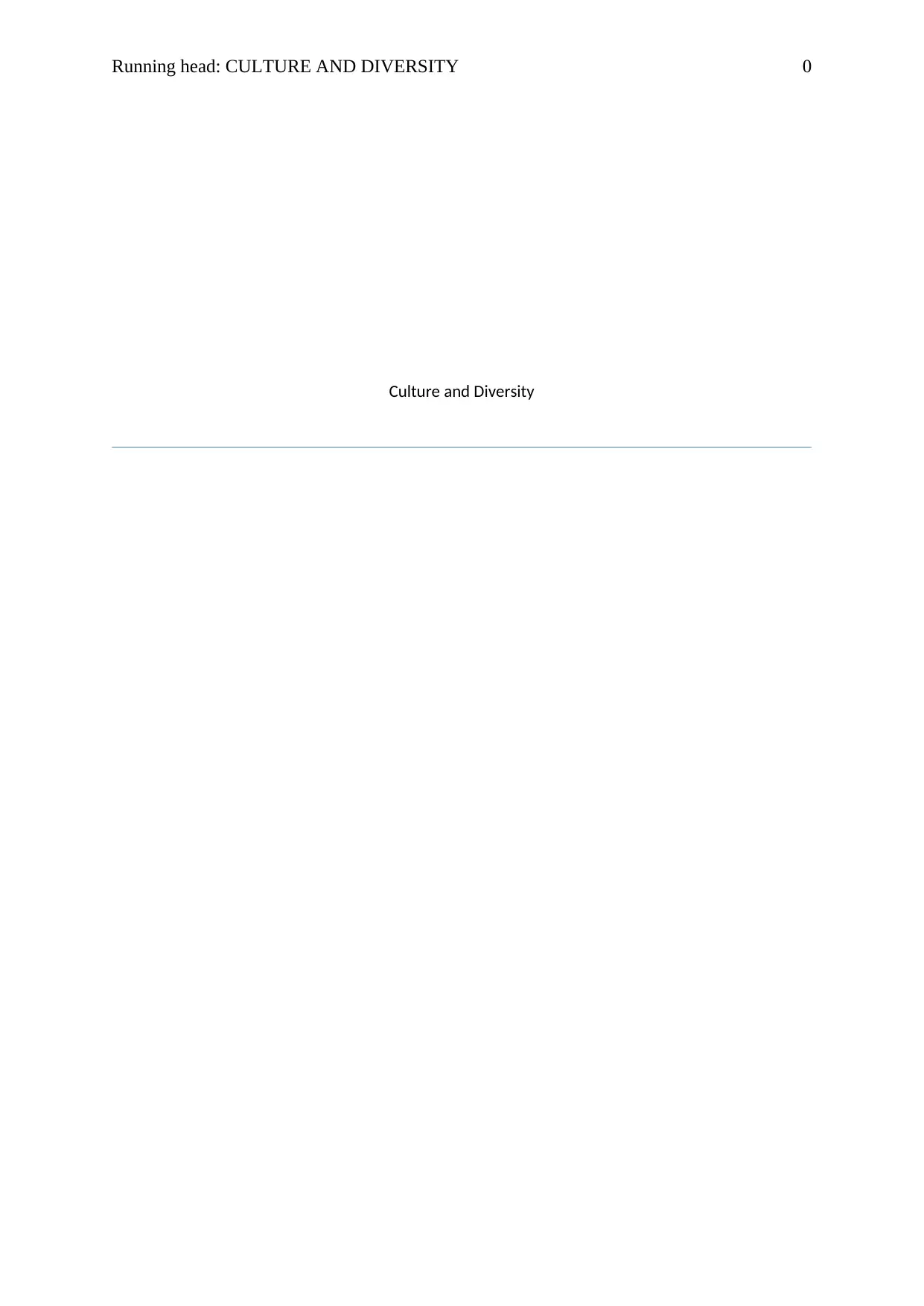
Running head: CULTURE AND DIVERSITY 0
Culture and Diversity
Culture and Diversity
Paraphrase This Document
Need a fresh take? Get an instant paraphrase of this document with our AI Paraphraser
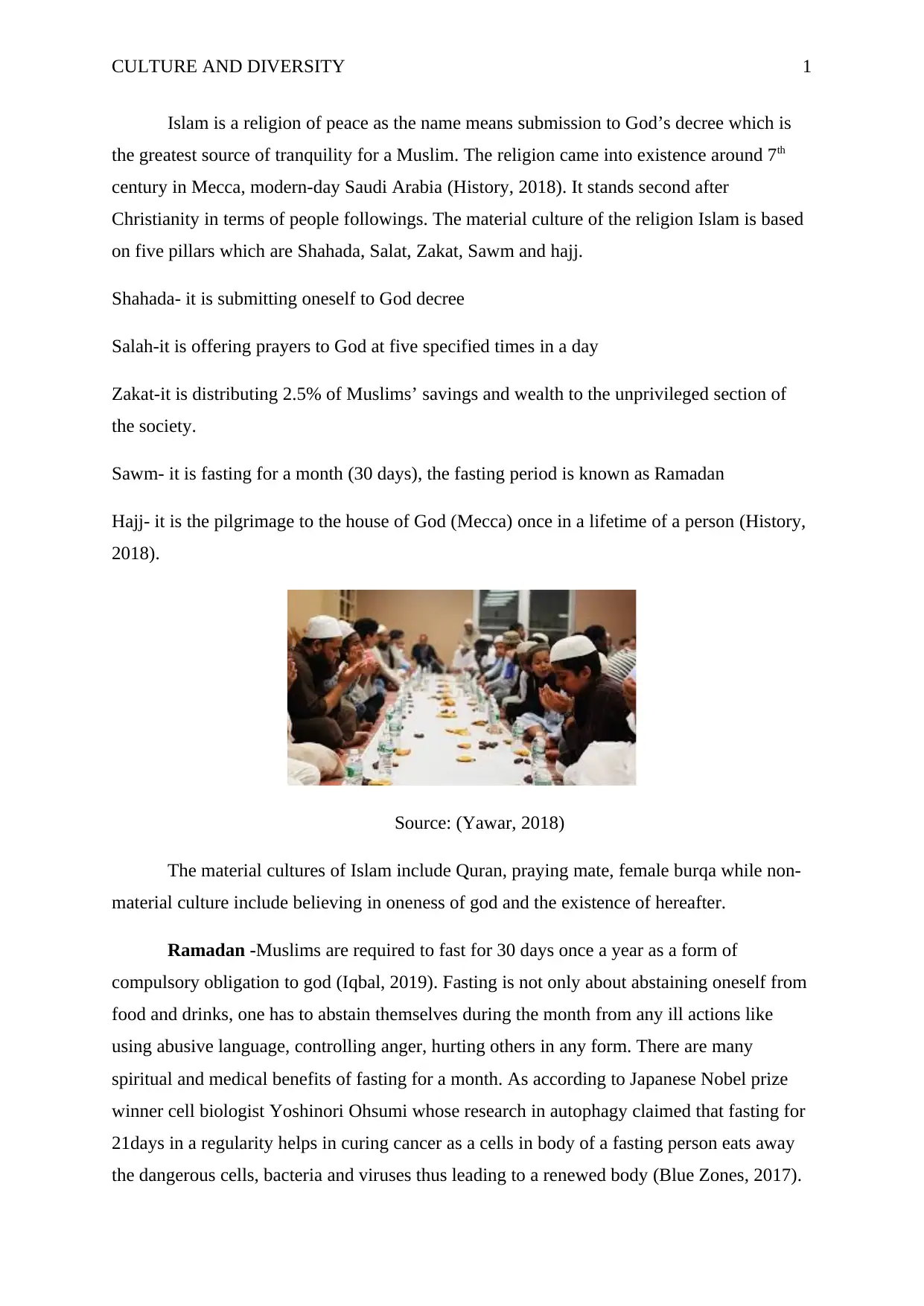
CULTURE AND DIVERSITY 1
Islam is a religion of peace as the name means submission to God’s decree which is
the greatest source of tranquility for a Muslim. The religion came into existence around 7th
century in Mecca, modern-day Saudi Arabia (History, 2018). It stands second after
Christianity in terms of people followings. The material culture of the religion Islam is based
on five pillars which are Shahada, Salat, Zakat, Sawm and hajj.
Shahada- it is submitting oneself to God decree
Salah-it is offering prayers to God at five specified times in a day
Zakat-it is distributing 2.5% of Muslims’ savings and wealth to the unprivileged section of
the society.
Sawm- it is fasting for a month (30 days), the fasting period is known as Ramadan
Hajj- it is the pilgrimage to the house of God (Mecca) once in a lifetime of a person (History,
2018).
Source: (Yawar, 2018)
The material cultures of Islam include Quran, praying mate, female burqa while non-
material culture include believing in oneness of god and the existence of hereafter.
Ramadan -Muslims are required to fast for 30 days once a year as a form of
compulsory obligation to god (Iqbal, 2019). Fasting is not only about abstaining oneself from
food and drinks, one has to abstain themselves during the month from any ill actions like
using abusive language, controlling anger, hurting others in any form. There are many
spiritual and medical benefits of fasting for a month. As according to Japanese Nobel prize
winner cell biologist Yoshinori Ohsumi whose research in autophagy claimed that fasting for
21days in a regularity helps in curing cancer as a cells in body of a fasting person eats away
the dangerous cells, bacteria and viruses thus leading to a renewed body (Blue Zones, 2017).
Islam is a religion of peace as the name means submission to God’s decree which is
the greatest source of tranquility for a Muslim. The religion came into existence around 7th
century in Mecca, modern-day Saudi Arabia (History, 2018). It stands second after
Christianity in terms of people followings. The material culture of the religion Islam is based
on five pillars which are Shahada, Salat, Zakat, Sawm and hajj.
Shahada- it is submitting oneself to God decree
Salah-it is offering prayers to God at five specified times in a day
Zakat-it is distributing 2.5% of Muslims’ savings and wealth to the unprivileged section of
the society.
Sawm- it is fasting for a month (30 days), the fasting period is known as Ramadan
Hajj- it is the pilgrimage to the house of God (Mecca) once in a lifetime of a person (History,
2018).
Source: (Yawar, 2018)
The material cultures of Islam include Quran, praying mate, female burqa while non-
material culture include believing in oneness of god and the existence of hereafter.
Ramadan -Muslims are required to fast for 30 days once a year as a form of
compulsory obligation to god (Iqbal, 2019). Fasting is not only about abstaining oneself from
food and drinks, one has to abstain themselves during the month from any ill actions like
using abusive language, controlling anger, hurting others in any form. There are many
spiritual and medical benefits of fasting for a month. As according to Japanese Nobel prize
winner cell biologist Yoshinori Ohsumi whose research in autophagy claimed that fasting for
21days in a regularity helps in curing cancer as a cells in body of a fasting person eats away
the dangerous cells, bacteria and viruses thus leading to a renewed body (Blue Zones, 2017).
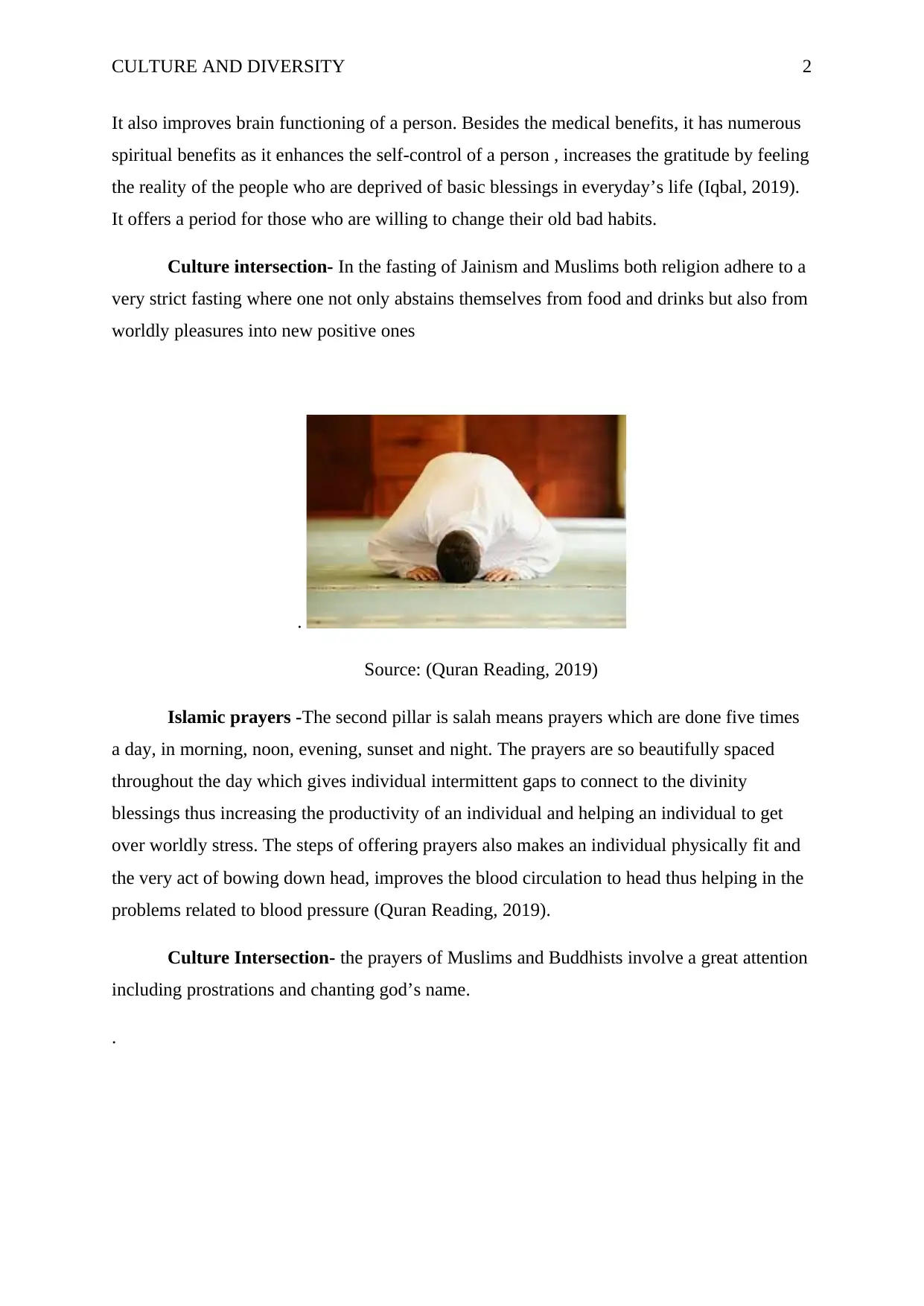
CULTURE AND DIVERSITY 2
It also improves brain functioning of a person. Besides the medical benefits, it has numerous
spiritual benefits as it enhances the self-control of a person , increases the gratitude by feeling
the reality of the people who are deprived of basic blessings in everyday’s life (Iqbal, 2019).
It offers a period for those who are willing to change their old bad habits.
Culture intersection- In the fasting of Jainism and Muslims both religion adhere to a
very strict fasting where one not only abstains themselves from food and drinks but also from
worldly pleasures into new positive ones
.
Source: (Quran Reading, 2019)
Islamic prayers -The second pillar is salah means prayers which are done five times
a day, in morning, noon, evening, sunset and night. The prayers are so beautifully spaced
throughout the day which gives individual intermittent gaps to connect to the divinity
blessings thus increasing the productivity of an individual and helping an individual to get
over worldly stress. The steps of offering prayers also makes an individual physically fit and
the very act of bowing down head, improves the blood circulation to head thus helping in the
problems related to blood pressure (Quran Reading, 2019).
Culture Intersection- the prayers of Muslims and Buddhists involve a great attention
including prostrations and chanting god’s name.
.
It also improves brain functioning of a person. Besides the medical benefits, it has numerous
spiritual benefits as it enhances the self-control of a person , increases the gratitude by feeling
the reality of the people who are deprived of basic blessings in everyday’s life (Iqbal, 2019).
It offers a period for those who are willing to change their old bad habits.
Culture intersection- In the fasting of Jainism and Muslims both religion adhere to a
very strict fasting where one not only abstains themselves from food and drinks but also from
worldly pleasures into new positive ones
.
Source: (Quran Reading, 2019)
Islamic prayers -The second pillar is salah means prayers which are done five times
a day, in morning, noon, evening, sunset and night. The prayers are so beautifully spaced
throughout the day which gives individual intermittent gaps to connect to the divinity
blessings thus increasing the productivity of an individual and helping an individual to get
over worldly stress. The steps of offering prayers also makes an individual physically fit and
the very act of bowing down head, improves the blood circulation to head thus helping in the
problems related to blood pressure (Quran Reading, 2019).
Culture Intersection- the prayers of Muslims and Buddhists involve a great attention
including prostrations and chanting god’s name.
.
⊘ This is a preview!⊘
Do you want full access?
Subscribe today to unlock all pages.

Trusted by 1+ million students worldwide
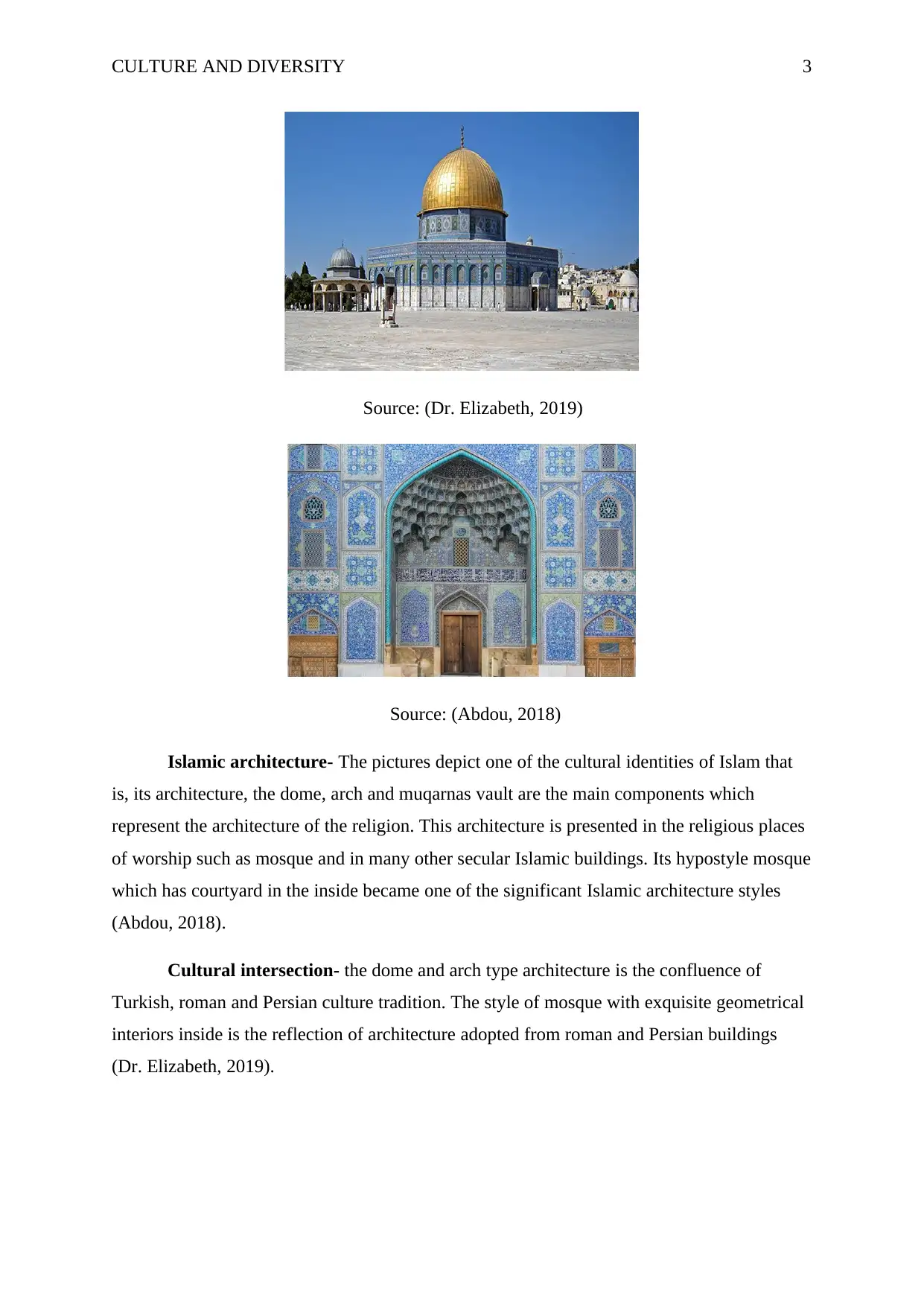
CULTURE AND DIVERSITY 3
Source: (Dr. Elizabeth, 2019)
Source: (Abdou, 2018)
Islamic architecture- The pictures depict one of the cultural identities of Islam that
is, its architecture, the dome, arch and muqarnas vault are the main components which
represent the architecture of the religion. This architecture is presented in the religious places
of worship such as mosque and in many other secular Islamic buildings. Its hypostyle mosque
which has courtyard in the inside became one of the significant Islamic architecture styles
(Abdou, 2018).
Cultural intersection- the dome and arch type architecture is the confluence of
Turkish, roman and Persian culture tradition. The style of mosque with exquisite geometrical
interiors inside is the reflection of architecture adopted from roman and Persian buildings
(Dr. Elizabeth, 2019).
Source: (Dr. Elizabeth, 2019)
Source: (Abdou, 2018)
Islamic architecture- The pictures depict one of the cultural identities of Islam that
is, its architecture, the dome, arch and muqarnas vault are the main components which
represent the architecture of the religion. This architecture is presented in the religious places
of worship such as mosque and in many other secular Islamic buildings. Its hypostyle mosque
which has courtyard in the inside became one of the significant Islamic architecture styles
(Abdou, 2018).
Cultural intersection- the dome and arch type architecture is the confluence of
Turkish, roman and Persian culture tradition. The style of mosque with exquisite geometrical
interiors inside is the reflection of architecture adopted from roman and Persian buildings
(Dr. Elizabeth, 2019).
Paraphrase This Document
Need a fresh take? Get an instant paraphrase of this document with our AI Paraphraser
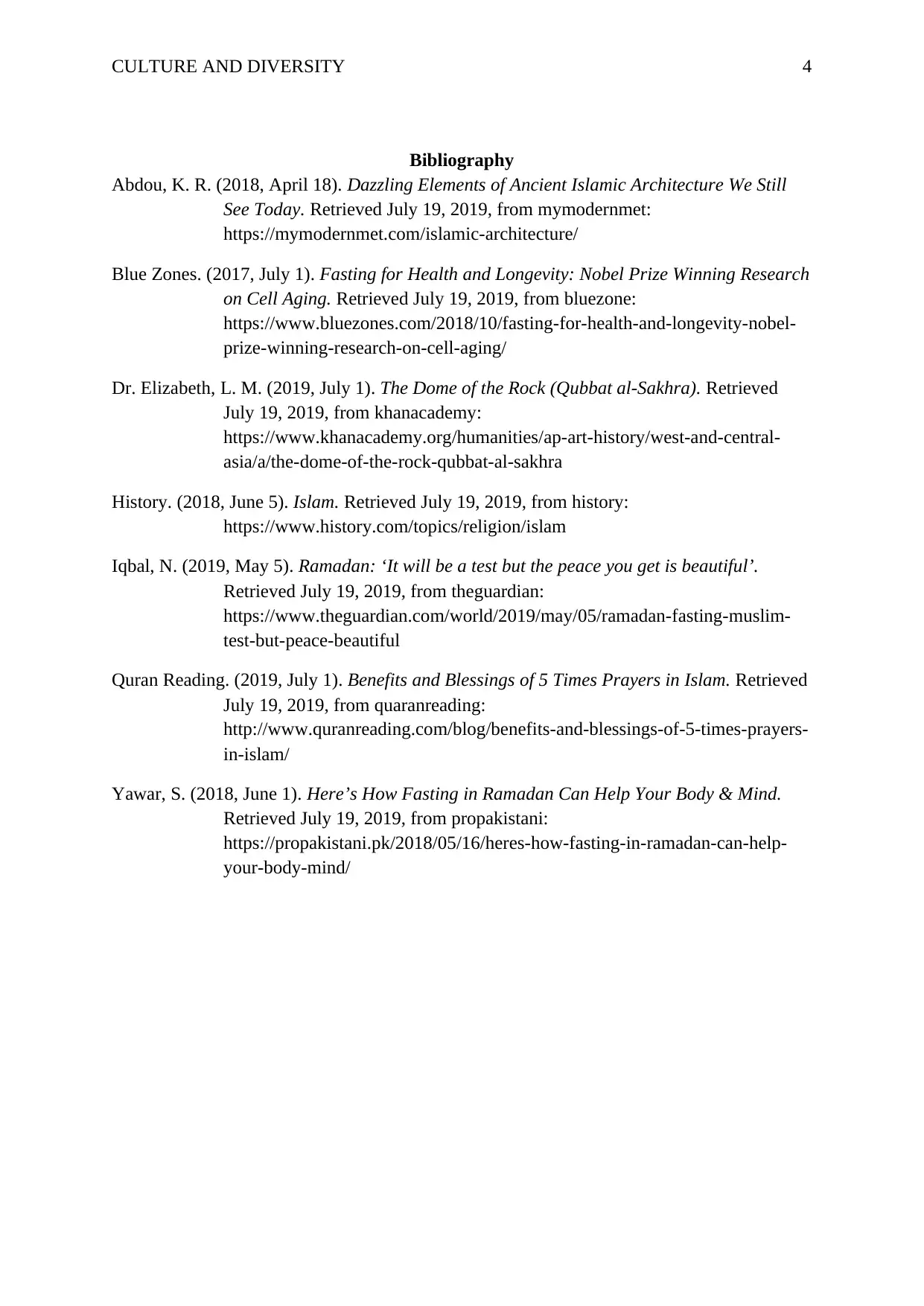
CULTURE AND DIVERSITY 4
Bibliography
Abdou, K. R. (2018, April 18). Dazzling Elements of Ancient Islamic Architecture We Still
See Today. Retrieved July 19, 2019, from mymodernmet:
https://mymodernmet.com/islamic-architecture/
Blue Zones. (2017, July 1). Fasting for Health and Longevity: Nobel Prize Winning Research
on Cell Aging. Retrieved July 19, 2019, from bluezone:
https://www.bluezones.com/2018/10/fasting-for-health-and-longevity-nobel-
prize-winning-research-on-cell-aging/
Dr. Elizabeth, L. M. (2019, July 1). The Dome of the Rock (Qubbat al-Sakhra). Retrieved
July 19, 2019, from khanacademy:
https://www.khanacademy.org/humanities/ap-art-history/west-and-central-
asia/a/the-dome-of-the-rock-qubbat-al-sakhra
History. (2018, June 5). Islam. Retrieved July 19, 2019, from history:
https://www.history.com/topics/religion/islam
Iqbal, N. (2019, May 5). Ramadan: ‘It will be a test but the peace you get is beautiful’.
Retrieved July 19, 2019, from theguardian:
https://www.theguardian.com/world/2019/may/05/ramadan-fasting-muslim-
test-but-peace-beautiful
Quran Reading. (2019, July 1). Benefits and Blessings of 5 Times Prayers in Islam. Retrieved
July 19, 2019, from quaranreading:
http://www.quranreading.com/blog/benefits-and-blessings-of-5-times-prayers-
in-islam/
Yawar, S. (2018, June 1). Here’s How Fasting in Ramadan Can Help Your Body & Mind.
Retrieved July 19, 2019, from propakistani:
https://propakistani.pk/2018/05/16/heres-how-fasting-in-ramadan-can-help-
your-body-mind/
Bibliography
Abdou, K. R. (2018, April 18). Dazzling Elements of Ancient Islamic Architecture We Still
See Today. Retrieved July 19, 2019, from mymodernmet:
https://mymodernmet.com/islamic-architecture/
Blue Zones. (2017, July 1). Fasting for Health and Longevity: Nobel Prize Winning Research
on Cell Aging. Retrieved July 19, 2019, from bluezone:
https://www.bluezones.com/2018/10/fasting-for-health-and-longevity-nobel-
prize-winning-research-on-cell-aging/
Dr. Elizabeth, L. M. (2019, July 1). The Dome of the Rock (Qubbat al-Sakhra). Retrieved
July 19, 2019, from khanacademy:
https://www.khanacademy.org/humanities/ap-art-history/west-and-central-
asia/a/the-dome-of-the-rock-qubbat-al-sakhra
History. (2018, June 5). Islam. Retrieved July 19, 2019, from history:
https://www.history.com/topics/religion/islam
Iqbal, N. (2019, May 5). Ramadan: ‘It will be a test but the peace you get is beautiful’.
Retrieved July 19, 2019, from theguardian:
https://www.theguardian.com/world/2019/may/05/ramadan-fasting-muslim-
test-but-peace-beautiful
Quran Reading. (2019, July 1). Benefits and Blessings of 5 Times Prayers in Islam. Retrieved
July 19, 2019, from quaranreading:
http://www.quranreading.com/blog/benefits-and-blessings-of-5-times-prayers-
in-islam/
Yawar, S. (2018, June 1). Here’s How Fasting in Ramadan Can Help Your Body & Mind.
Retrieved July 19, 2019, from propakistani:
https://propakistani.pk/2018/05/16/heres-how-fasting-in-ramadan-can-help-
your-body-mind/
1 out of 5
Your All-in-One AI-Powered Toolkit for Academic Success.
+13062052269
info@desklib.com
Available 24*7 on WhatsApp / Email
![[object Object]](/_next/static/media/star-bottom.7253800d.svg)
Unlock your academic potential
Copyright © 2020–2025 A2Z Services. All Rights Reserved. Developed and managed by ZUCOL.


